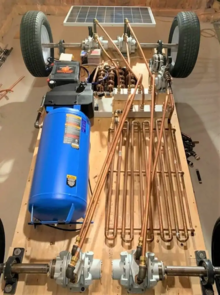This article possibly contains unsourced predictions, speculative material, or accounts of events that might not occur. Information must be verifiable and based on reliable published sources. (August 2023) |


A compressed-air car is a compressed-air vehicle powered by pressure vessels filled with compressed air. It is propelled by the release and expansion of the air within a motor adapted to compressed air. The car might be powered solely by air, or combined (as in a hybrid electric vehicle) with other fuels such as gasoline, diesel, or an electric plant with regenerative braking.
Compressed-air cars use a thermodynamic process. Air cools when expanding and heats when compressed. Thermal energy losses in the compressor and tankage reduce the capacity factor of compressed air systems.
In 2020, Dr. Reza Alizade Evrin of Ontario Tech University developed an isothermal compressed air vehicle.[1][2] This prototype used low pressure air tanks and exhaust air recovery to power a paraffin heat exchanger system. Its energy efficiency reached 74%. This is as much as 90% of the efficiency of lithium-ion electric cars. It had a driving range of 140 km. Efficiency and range might be increased by a number of practical improvements. For example, combining the storage tank into the car chassis, higher pressure tanks, new rotary engines, and a more efficient heat exchanger. Also, the weight and cost of tanks and pneumatic parts might be reduced by using recycled and bio-based thermoplastics.
This technology might develop into an inexpensive, clean transportation technology. The energy, vehicles and compressors might be produced easily by decentralized methods, even circular industry. Using plastic might permit open source fabrication using numerical control, including additive manufacturing. The compressed air for such vehicles might be produced easily by common types of renewable energy. For example, multistage air compressors and intercoolers or hydraulic pumps might be attached directly to trompes, hydropower, VAWT wind turbines or stirling engines using a solar concentrator. Direct mechanical compression avoids the Carnot inefficiencies of heat engines. Insulated storage of compressed air avoids energy conversion and battery storage. Heat-based systems might use tankage of solar-heated molten salts driving a heat exchanger rather than an onboard heat recovery system. Electric energy, electric grids and their issues might be avoided.
- ^ a b "Compressed air cars for urban transportation". advancedsciencenews. 7 September 2020. Retrieved 2020-09-07.
- ^ a b Evrin, Reza Alizade; Dincer, Ibrahim (2020). "Experimental investigation of a compressed air vehicle prototype with phase change materials for heat recovery". Energy Storage. 2 (5). onlinelibrary.wiley. doi:10.1002/est2.159. S2CID 219020514. Retrieved 2020-04-27.